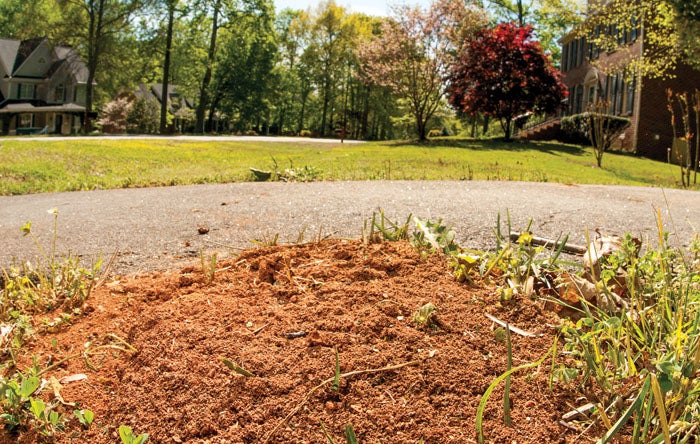Controlling fire ants in your lawn
Published 12:00 am Sunday, April 5, 2020

- Fire ant mound in lawn
By Amy-Lynn Albertson
Rowan County Extension director
Fire ants are similar in appearance to many other ants, so make sure you have correctly identified the species before attempting to solve your ant problem. Fire ants are very aggressive and will attack anything that disturbs the mound, other ants will usually just run away. Another way to know for sure if you have fire ants is to put out a potato chip near the mound or some cat food. Fire ants are attracted to greasy foods and will locate it quickly to take back in the colony.
Most people try to control fire ants by treating individual mounds. An effective mound treatment must kill the queen; otherwise, the colony will survive. Some nests may go undetected. Even places where every mound has been treated can soon be re-infested by fire ant colonies migrating from untreated areas.
The two-step method is the most cost-effective and environmentally sound approach to treating medium to large landscaped areas. First, broadcast baits twice a year to reduce fire ant colonies by as much as 80%. The second step is to treat nuisance mounds or colonies that move into the bait-treated areas. The bait you apply determines how quickly ants will be controlled and how long the effect will last. Faster-acting bait products include indoxacarb (works in 3-7 days), metaflumizone (works in 7-10 days), hydramethylnon (works in 7-14 days for mound treatments and in 2-3 weeks when broadcast), and spinosad. These baits may need to be reapplied more often than slower acting and longer-lasting products such as abamectin, methoprene or pyriproxyfen, which work in 1-2 months when applied in spring and six months when applied in fall. Products that combine fast- and slow-acting ingredients, such as hydramethylnon plus methoprene (Extinguish Plus or Amdro Yard Treatment), may control ants better because they act quickly and last longer. Certified organic products that contain spinosad such as Fertilome Come and Get It! or Payback Fire Ant Bait can be used for broadcast bait and single mound treatments where an organic product is required. These products may also be used in organic vegetable gardens (make sure and read the label for specifics). Use products such as Amdro Pro, Esteem, Extinguish or Extinguish Plus for livestock pastures and hayfields.
Individual mounds may be treated with a liquid or dust insecticide formulation or with an insecticidal bait. An effective drench must trickle down through the mound and contact most of the fire ants in the colony. Ants contacted by the drench die in less than 24 hours. Drenches are the preferred treatment when the risk of human contact with fire ants is high, and the fire ant infestation must be eliminated immediately because of the health risks of someone getting stung. High-risk areas include home lawns, school grounds, parks, and other areas frequently used by the public. Best control results are usually obtained in spring and fall when temperatures are between 70 and 85 degrees. For more information on fire ants or other horticultural topics, contact the Rowan County Extension Center at 704-216-8970 or go to http://rowan.ces.ncsu.edu
Disclaimer: Recommendations for the use of chemicals are included in this article as a convenience to the reader. The use of brand names and any mention or listing of commercial products or services in this article does not imply endorsement by North Carolina Cooperative Extension nor discrimination against similar products or services not mentioned. Individuals who use chemicals are responsible for ensuring that the intended use complies with current regulations and conforms to the product label. Read and follow all label directions when using any pesticide.




